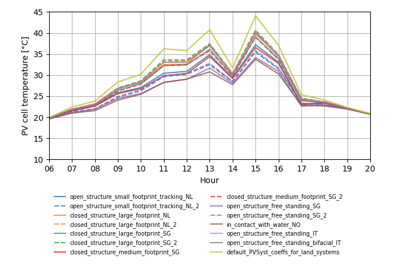pvlib.temperature.pvsyst_cell#
- pvlib.temperature.pvsyst_cell(poa_global, temp_air, wind_speed=1.0, u_c=29.0, u_v=0.0, module_efficiency=0.1, alpha_absorption=0.9)[source]#
Calculate cell temperature using an empirical heat loss factor model as implemented in PVsyst.
- Parameters:
poa_global (numeric) – Total incident irradiance [W/m^2].
temp_air (numeric) – Ambient dry bulb temperature [C].
wind_speed (numeric, default 1.0) – Wind speed in m/s measured at the same height for which the wind loss factor was determined. The default value 1.0 m/s is the wind speed at module height used to determine NOCT. [m/s]
u_c (float, default 29.0) – Combined heat loss factor coefficient. The default value is representative of freestanding modules with the rear surfaces exposed to open air (e.g., rack mounted). Parameter \(U_{c}\) in (1). \(\left[\frac{\text{W}/{\text{m}^2}}{\text{C}}\right]\)
u_v (float, default 0.0) – Combined heat loss factor influenced by wind. Parameter \(U_{v}\) in (1). \(\left[ \frac{\text{W}/\text{m}^2}{\text{C}\ \left( \text{m/s} \right)} \right]\)
module_efficiency (numeric, default 0.1) – Module external efficiency as a fraction. Parameter \(\eta_{m}\) in (1). Calculate as \(\eta_{m} = DC\ power / (POA\ irradiance \times module\ area)\).
alpha_absorption (numeric, default 0.9) – Absorption coefficient. Parameter \(\alpha\) in (1).
- Returns:
numeric, values in degrees Celsius
Notes
The Pvsyst model for cell temperature \(T_{C}\) is given by
(1)#\[ T_{C} = T_{a} + \frac{\alpha E (1 - \eta_{m})}{U_{c} + U_{v} \times WS}\]Inputs to the model are plane-of-array irradiance \(E\) (W/m2), ambient air temperature \(T_{a}\) (C) and wind speed \(WS\) (m/s). Model output is cell temperature \(T_{C}\). Model parameters depend both on the module construction and its mounting. Parameters are provided in [1] for open (freestanding), close (insulated), and intermediate (semi_integrated) mounting configurations, and are coded for convenience in
TEMPERATURE_MODEL_PARAMETERS. The heat loss factors provided represent the combined effect of convection, radiation and conduction, and their values are experimentally determined.Mounting
\(U_{c}\)
\(U_{v}\)
freestanding
29.0
0.0
insulated
15.0
0.0
semi_integrated
20.0
0.0
Mounting cases can be described in terms of air flow across and around the rear-facing surface of the module:
“freestanding” refers to mounting that allows relatively free air circulation around the modules. This case is typical of ground-mounted systems on tilted, fixed racking or single axis trackers.
“insulated” refers to mounting with air flow across only the front surface. This case is typical of roof-mounted systems with no gap behind the module.
References
Examples
>>> from pvlib.temperature import pvsyst_cell, TEMPERATURE_MODEL_PARAMETERS >>> params = TEMPERATURE_MODEL_PARAMETERS['pvsyst']['freestanding'] >>> pvsyst_cell(1000, 10, **params) 37.93103448275862

